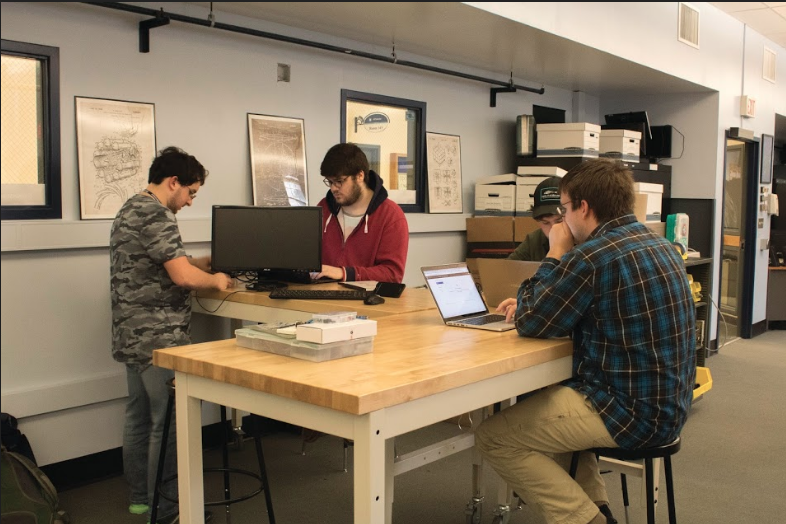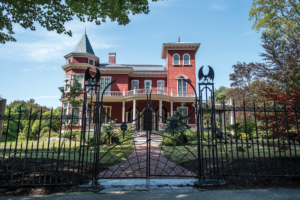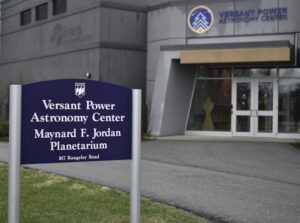In the back corner of the Hackerspace lab lies a table completely covered with plants. Though it may seem hard to believe at first, these plants are arguably the most important piece of technology that’s being used in the third annual 24-hour civic Hackathon. This year, the Hackathon focused on integrating technology with agriculture, in particular, small farmers and agricultural dependent businesses.
Michael Potiska is an administrative specialist with the Center for Innovation in Teaching and Learning, as well as a member of UMaine’s Hackerspace advisory board.
“With the theme of this year’s Hackathon being around small agriculture, we wanted to make sure that students and participants had direct access to plants so that they could actually use the sensors we’re providing. We have soil moisture sensors, photo sensors, and a variety of other ones that will help students pull information from the plants and figure out how they’re living, what their environment is like, and to give them the opportunity to actually use those sensors to their full ability,” Potiska said. “The sponsors we’re working with from UMaine have provided 160 plants for participants to have direct access to and they’ll be able to check them out just like they would with a piece of technology. The plants are just as much hardware for this event as the sensors and all of the other tech.”
Along with the various projects that students conducted over the course of the all-day event, students also participated in featured prize challenges. The hacking took place in various rooms across the Memorial Union including the Hackerspace the Totman room and the Walker room. The hacking began at 1:30 p.m. on Saturday, March 2, and ended at 1 p.m. the next day.
“There are a few categories that we’re going to be asking students to work in. One is what kind of information can you collect from a plant, or the orchard, or the maple tree or whatever it is you’re working with and how will you get that information back to someplace where it can be processed,” Peter Schilling, the director of innovation in teaching and learning, said. “Another part is figuring out once you get that information, what are you doing with it. Can you send it to an app on a phone that can help a farmer visualize it and take action? Another criteria … will be the cost. The less expensive it is the better because it’s about small farmers and families and how we can make solutions available to those people.”
The Hackerspace lab is a relatively new edition to the facility. The space was inspired by the collaborative media lab in the Raymond H. Fogler Library that began in 2001 in order to give students access to hardware and software they otherwise wouldn’t have access to.
“At that time there wasn’t a whole lot of digital media technology that was available to students. We had a conversation again in 2015-2016 to see what we could do today to give students access, and that sort of folded into a technology toolkit that we believed every student coming out of the university should have,” Schilling said. “They way in which they’re going to collect information and analyze data has a lot to do with apps and phones, but it also has to do with drones and robotics and all that stuff. So, instead of the original collaborative media lab where the gear was expensive and high end, now it’s just new, so Hackerspace is really designed to give students access to a suite of hardware and software that they can experiment with and use to figure out questions and answers.”
The inception of the lab came from research that was being conducted by other departments at UMaine. One such group was the marine research lab that, just like the students at Hackathon, works to find solutions to problems in small agriculture and find safer and less expensive ways to study the inhabitants of the ocean.
“When I pitched Hackerspace, the marine research lab was tracking the migration patterns of orcas. A generation ago you would get in a little rubber boat with a gigantic hypodermic needle and every couple of days you’d chase down the orcas and freak everybody out. I’m sure it was a grad student who figured out that we could duct tape sponges to drones and fly them through the spouts,” Schilling said. “They got better data, no one was freaked out, and it got their project off to a great start. From there, the idea of Hackerspace grew alongside other projects and labs at the university.”
The Hackerspace lab is continuously coming up with innovative ideas to help improve the technology of today. The lab is equipped with internet devices and prototype resources, making this year’s Hackathon an exciting event on campus. The space is available to all students and can even be reserved for use by clubs and organizations.
For more information about Hackerspace, visit the lab in room 114 of the Memorial Union or visit its website at umaine.edu/hackerspace. You can also follow them on twitter at @UM_Hackerspace to see updates on Hackathon and weekly ongoings in the lab.










